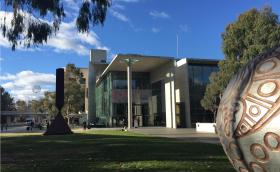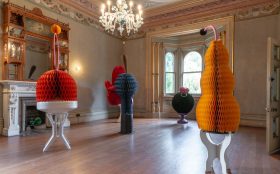Louise Feneley and Renate Nisi exhibition at Hill-Smith Gallery
Recent works: 9-25 November 2007
One of my birthday treats this year was to attend the opening of a sumptuous exhibition by my friend, Louise Feneley and her friend, Renate Nisi. These two accomplished women artists have quite a following, if the opening night at Hill-Smith Gallery in Pirie St, Adelaide, is anything to go by.
It was a joy to see so many red stickers on the works, even a few hours before the ‘official’ opening. My partner and I had sneaked an early peek at the works before the gallery filled to the brim and the patrons spilled out into the warm night air of Adelaide’s CBD.
I have been a devotee of Feneley’s works since we met a few years ago. I call her
a painter’s painter, though her work has proved highly accessible to a wider following.
Her evolution as an artist has taken place over a long period and it is perhaps this lengthy gestation that has created such masterful works. My prediction is that Feneley’s art will stand the test of time because both her raison d’etre and her artistic techniques are solid and profound.
The same can be said of sculptor Renate Nisi. Nisi’s work in Carrara marble, bronze, steel, copper (et al) has been crafted with an equal integrity and artistic intensity of purpose.
According to opening night speaker and artist, Evette Sunset, both women are “turning their gaze inwards” as they enter the latter part of their lives; “thinking about who they want to be before they leave” (sic. ‘this mortal coil’) and “communicating the intangible to the viewer.” Both artists are “concerned with the human condition and the quiet, restrained but inner power (of the works) creates a sense of mystery.” Also, according to Sunset, both are dedicated to the “quest of communicating exactly but subtly” what Nisi calls “ponderings on the intimate”, and Feneley “hinting or stalking a meeting between the personal or creative and a greater force that is.”
Feneley’s transcendental images connect the viewer to their own inner processes. By creating works that play on both the representational and the abstract, the viewer’s imagination has plenty of room to move. Feneley is using folded fabric as a starting point for aesthetically delightful metaphors that lead the viewer to a meditative place, a sacred space.
Works such as Cycle of Tides and Who Am I? demonstrate the strength and breathtaking sensuality of Feneley’s art. Both these works were sold before the exhibition had officially opened. Other favourites of mine were Still Point and Mysteria I.
Similarly, one’s senses were stimulated by Nisi’s highly refined and sensitive sculptures, many of which featured the expressive gestures of human hands.
The Carrara marble was ‘soft’ and luminous in appearance; urging one to respond to the humanness of the art. My favourite was Nisi’s In the Zone (Carrara Marble, copper, wood) – a meditation on meditation, that called to mind yogic practice, contemporary spiritual yearning and Renaissance aesthetic expression. I also loved to make, to have, to give (Carrara marble, copper, steel, wood) where the gestural aspect of the sculpture directly reaches out to the viewer and strongly evokes a desire to respond.
The juxtaposition of painting and sculpture in a gallery can be a mutually responsive, satisfying experience for artists and viewer, or one compromised by the very different aesthetic and spatial demands of the work. Mostly, in this case, the juxtaposition worked well, though, at times, the sculptures needed ‘containment’ in their own particular environment.
Feneley is poised at the juncture between one direction and another in her art. New subject matter – primarily inspired by her relocation from a life in the Adelaide Hills to a new home by the sea, has begun its journey in her psyche and her art. She seems to be hesitating before jumping in; knowing how much her public is now attuned to her earlier motifs.
I have some reservations about the new works. This sense of transition may be what bothers me. Certainly, the triptychs while exciting in one sense, also lack the sense of conviction that her established works have in their presence, scale and aesthetic cohesion.
In her triptych What is this Life? (oil on Belgian linen), we meet the artist herself. However, those who may want to purchase the work will be disappointed that only two out of three parts of it are for sale and this does not include the self-portrait. In her other triptych, Summoning the boat (oil on Belgian linen), a degree of obvious aesthetic contrivance undermines one’s ability to direct their attention away from technique and simply imbibe the mood. Even so, Feneley is to be congratulated for her desire to ‘break out’ and not fall into any kind of spiritual or artistic complacency or stagnation.
Overall, both Feneley and Nisi succeed in manipulating mundane processes to give the viewer the opportunity to “ponder the imponderable” (Nisi, 2007). Indeed, it is a refreshing pleasure to be given the space to dream; to be led into a contemplative space beyond language where one can so directly experience the intuitive, intangible, ecstatically soulful yearnings of our humanness.





